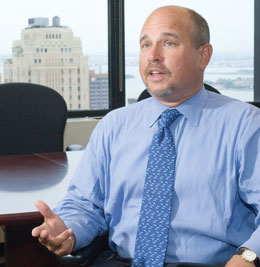 |
 |
 |
|
Environmental liability The past is prologue By Dennis H. Pillsbury One does not have to be rivaling Methuselah to remember just how difficult the environmental liability market was. Although the talk has died down, Superfund continues to be a topic of conversation within the industry and at cocktail parties where jokes are told that involve lawyers and Superfund sites in New Jersey and California. When pollution is mentioned in insurance circles, visions of huge liabilities a la the asbestos crisis come to mind, sending some underwriters into a glassy-eyed trance. And, even without the lawyer jokes, it is not a field without some anecdotal amusement, if one’s amusement tends toward the darker side of funny. Ken Berger, head of environmental for Zurich North America Commercial, points to one example. “We insured an asbestos contractor who was removing asbestos from a school. The contractor used water to keep the dust down. We had no claims resulting from asbestos exposure, but we ended up paying for a school full of mold.” Zurich has been insuring companies with environmental risks for more than 14 years. “Our remedial contractor and consultant customers have had claims from issues that we did not expect,” Ken says, “and most of those claims centered around property damage and cleanup costs.” Despite the widespread concern about bodily injury from pollution, Ken says, “most of the losses were property damage losses.” Environmental concerns quickly became a Main Street business issue, Ken explains. Businesses that wanted to enter a particular community had to worry about the past owner. A corner lot might have belonged to a gas station and there could be an underground storage tank. A small business might go into a building that was once a dry cleaning establishment or a printer and which might have some lingering environmental exposure from the chemicals used in those businesses. They also were a concern for banks because “the property often is held as collateral when there is a business loan,” Ken says. “Under Superfund, banks need a creditor exemption.” This became critical in the 1990s. In order to protect themselves, banks began doing Phase I assessments of a property, which were essentially walk-throughs of the property. “This really took a significant amount of time and held up the loan process,” Ken continues. “We looked at the situation and began offering an insurance policy that introduced more certainty to the Phase I process. We were one of the first to offer a lenders environmental insurance policy. It’s a business that has been growing slowly but steadily,” he adds. “Most of our customers were medium-sized banks, but larger ones now are starting to come on board.” The exposures The brownfields movement, where new owners clean up and bring properties back to use, has been a “slow but growing area.” Many of these sites were Superfund sites, and buyers were scared off by the potential liabilities. But the combination of insurance coverage and less burdensome regulation by the EPA has allowed businesses to move into existing sites without fear of a door-closing environmental lawsuit. Similar to the brownfields movement is the military base cleanup where the military cleans up bases that have been closed so they can be used for other purposes. Here too, Zurich offers coverage for environmental exposures. “That market has been slower in the last two years due to the war and few base closings,” Ken notes. “However, we expect a steady stream of business in the future.” Ken adds, “We write coverage for all the people who abate environmental hazards. The most recent are mold abatement firms. That’s been the hot area recently.” He continues, “Mold is a management issue. In some cases, an entire home or business has to be rebuilt, but the key is to recognize what the proper action is and take it quickly. Zurich has been very effective in risk management of environmental exposures. We provide seminars for our agents on a variety of topics, including properly crafting contracts, environmental cost consulting, and remediation estimates. We have the experts in house to help agents and their customers in these areas. This can be especially important if an agent has a client that is involved in a merger or acquisition,” he says. Accounting requirements Ken points out that a confluence of events has been driving the environmental market—FIN 47, which requires companies to show estimated future environmental liabilities on the balance sheet, and confusion around the proper use of finite insurance combined with risk transfer to manage environmental liabilities. Integrated insurance programs using both risk transfer and finite techniques were growing in the environmental area until industry issues clouded such deals. “It will be difficult to sort out in the current environment,” Ken says. FIN 47 is an interpretation by the Financial Accounting Standards Board of Statement No. 143, which deals with the accounting treatment of asset retirement obligations. FIN 47 took effect in December 2005. Although the impact of FIN 47 is not yet known, cfo.com reports that it has already resulted in “modest hits to net income and earnings per share” for some companies. The cfo.com article goes on to note that “Ford Motor Co. recorded a $251 million after-tax charge to net income for 2005 and an accompanying 11-cent reduction in earnings per share.” Other companies that also posted charges, according to the article, were United Technologies Corp., USG Corp., and ConocoPhillips. The article quotes Greg Rogers, president of the consulting firm Advanced Environmental Dimensions, as being concerned about “financially troubled companies” where “booking a significant liability could tip the balance sheet of a distressed company into bankruptcy.” He also points out that “any company with an official pact obligating it to clean up before shuttering a site could be affected, including tiny neighborhood dry cleaners or home-heating oil companies with oil storage tanks.” Good news “Environmental exposures have been around for quite some time now,” Ken concludes, “and insurance companies have developed the data they need to price the product. Businesses that need coverage should be able to find policies at prices that are realistic. Nearly all of the companies that remain in this market are veterans that understand the market and underwrite accordingly. That certainly is the case with Zurich.” * For more information: |
|
|||||||||||||||||
| ||||||||||||||||||


